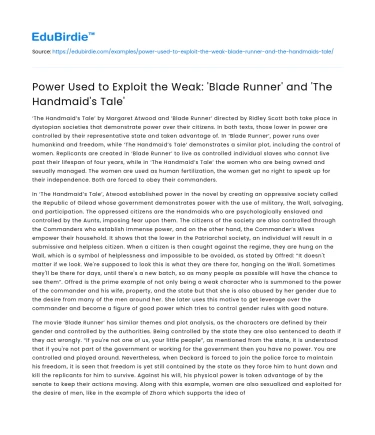‘The Handmaid’s Tale’ by Margaret Atwood and ‘Blade Runner’ directed by Ridley Scott both take place in dystopian societies that demonstrate power over their citizens. In both texts, those lower in power are controlled by their representative state and taken advantage of. In ‘Blade Runner’, power runs over humankind and freedom, while ‘The Handmaid’s Tale’ demonstrates a similar plot, including the control of women. Replicants are created in ‘Blade Runner’ to live as controlled individual slaves who cannot live past their lifespan of four years, while in ‘The Handmaid’s Tale’ the women who are being owned and sexually managed. The women are used as human fertilization, the women get no right to speak up for their independence. Both are forced to obey their commanders.
In ‘The Handmaid’s Tale’, Atwood established power in the novel by creating an oppressive society called the Republic of Gilead whose government demonstrates power with the use of military, the Wall, salvaging, and participation. The oppressed citizens are the Handmaids who are psychologically enslaved and controlled by the Aunts, imposing fear upon them. The citizens of the society are also controlled through the Commanders who establish immense power, and on the other hand, the Commander’s Wives empower their household. It shows that the lower in the Patriarchal society, an individual will result in a submissive and helpless citizen. When a citizen is then caught against the regime, they are hung on the Wall, which is a symbol of helplessness and impossible to be avoided, as stated by Offred: “It doesn't matter if we look. We're supposed to look this is what they are there for, hanging on the Wall. Sometimes they'll be there for days, until there's a new batch, so as many people as possible will have the chance to see them”. Offred is the prime example of not only being a weak character who is summoned to the power of the commander and his wife, property, and the state but that she is also abused by her gender due to the desire from many of the men around her. She later uses this motive to get leverage over the commander and become a figure of good power which tries to control gender rules with good nature.
Save your time!
We can take care of your essay
- Proper editing and formatting
- Free revision, title page, and bibliography
- Flexible prices and money-back guarantee
The movie ‘Blade Runner’ has similar themes and plot analysis, as the characters are defined by their gender and controlled by the authorities. Being controlled by the state they are also sentenced to death if they act wrongly. “If you're not one of us, your little people”, as mentioned from the state, it is understood that if you're not part of the government or working for the government then you have no power. You are controlled and played around. Nevertheless, when Deckard is forced to join the police force to maintain his freedom, it is seen that freedom is yet still contained by the state as they force him to hunt down and kill the replicants for him to survive. Against his will, his physical power is taken advantage of by the senate to keep their actions moving. Along with this example, women are also sexualized and exploited for the desire of men, like in the example of Zhora which supports the idea of men’s power over women in the movie.
In conclusion, power can be favorable when it is in pair with good leadership, as control is always needed on a group of citizens which make up a society, for it to function properly. But as like anything exaggerated, too much power leads to unfavorable control that diminishes the individual freedom of the citizens and intervenes with their ordinary lives. Nowadays, we have both good and evil powers existing in the world, but it won’t be long for our society to end up like in one of the dystopian worlds seen in ‘The Handmaid’s Tale’ and ‘Blade Runner’. The ‘weak’, which in both cases are the oppressed society and its residents, mainly those of women, are in truth weak only because they do not hold much power as they are incomers from a lower class. Through both pieces of work, Atwood and Scott demonstrate the potential of the use of power, particularly over the natural world, the inferior, and women. This causes strong emotional responses which in both cases successfully raises questions, provokes rage, and thought.






 Stuck on your essay?
Stuck on your essay?

